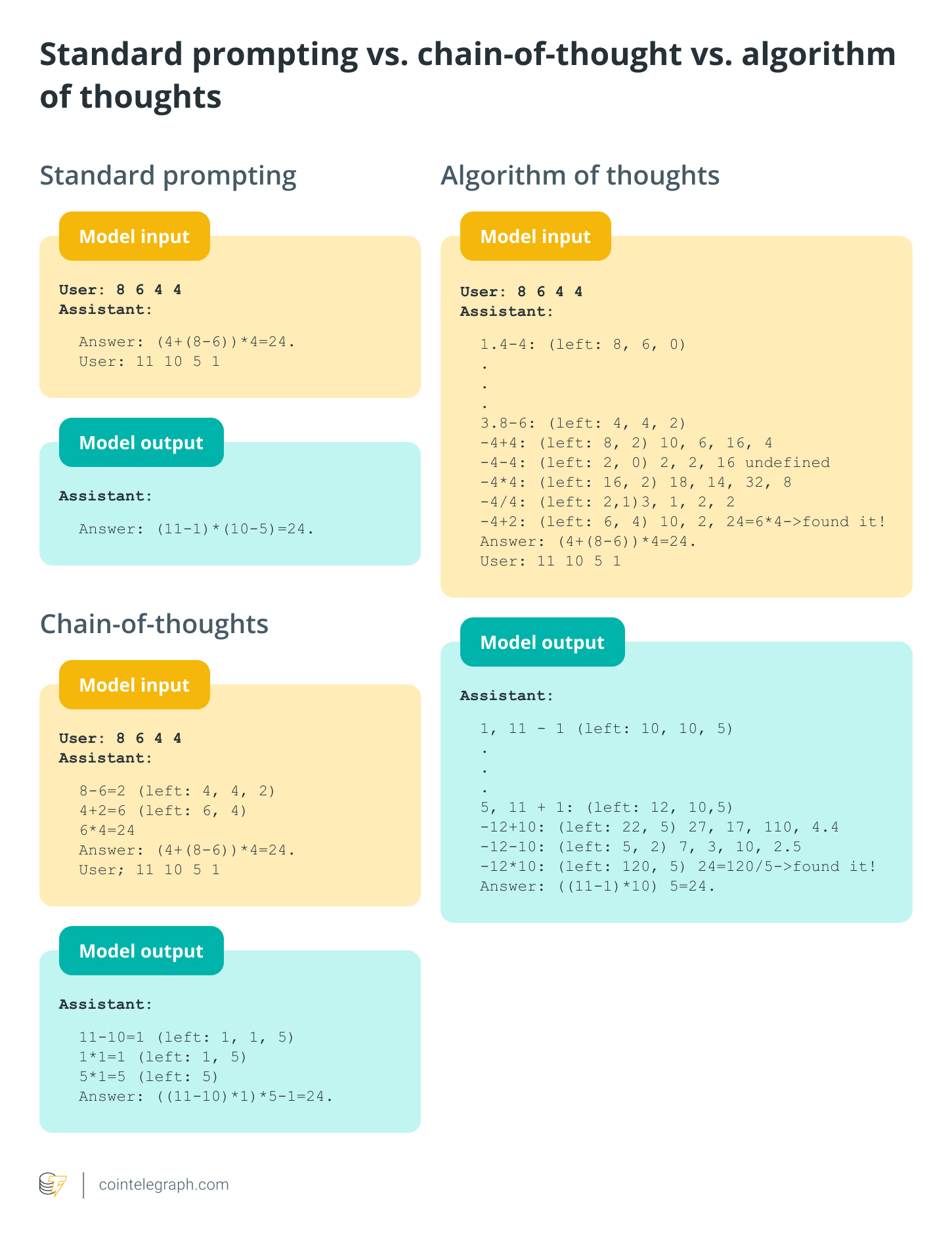
Explain Algorithm of Thoughts (AoT).
AoT technology enhances AI thinking by mimicking human thought processes, thereby improving adaptability and problem-solving efficiency.
Algorithm Thinking (AoT) is a pioneering approach to artificial intelligence (AI) that is revolutionizing the way AI models think and reason. Developed by Microsoft Research, AoT introduces a new paradigm for large language models (LLMs) for approaching complex problems with enhanced reasoning capabilities. It aims to combine the best of both worlds: a precise and intuitive understanding of human thought processes with the structured and systematic nature of algorithmic methodologies.
AoT contrasts with previous approaches that relied on external interventions to guide LLMs through the stages of reflection. Instead, it exploits LLM students’ latent abilities to explore the problem space by simulating human-like thought patterns. This allows LLM students to dynamically adjust their approach depending on the context, making them more adaptable and effective.
The image above shows different strategies for solving inference problems with LLMs. It shows the progression from basic motivation to more complex methods such as idea chain, idea tree and idea algorithm. Each box represents an idea, with green indicating promising ideas and red indicating less promising ideas, guiding the LLM toward the solution.
These strategies are explained below:
- Essential Prompt: Ask the LLM a direct question or give them a task.
- Chain of Thoughts (CoT): LLM generates a series of intermediate thinking steps before arriving at the final answer, such as explaining one’s thought process.
- Idea Tree (ToT): LLM explores multiple thought paths simultaneously, evaluates each path, and selects the most promising path to follow, such as brainstorming different approaches.
- Algorithmic Thinking (AoT): combines CoT and ToT, using algorithms to systematically search and evaluate different paths of thinking, as a more organized and efficient way of finding solutions.
Essentially, AoT allows AI models to navigate through a wide range of possibilities, in the same way that humans brainstorm and refine their ideas to arrive at solutions. This approach has shown great promise in improving the performance of LLMs in various inference tasks, outperforming previous approaches in terms of accuracy, efficiency, and flexibility.
How does AoT outperform existing methods?
AoT technology revolutionizes AI by making inference transparent, efficient and adaptable, going beyond traditional problem-solving and decision-making models.
AoT represents a revolutionary approach to artificial intelligence, fundamentally changing the way humans understand and use LLMs. Its superiority over traditional models is particularly evident in its variable reasoning process. The AoT makes this process transparent, providing a step-by-step breakdown of the model’s ideas, unlike the opaque “black box” nature of previous LLMs.
In addition to transparency, AoT significantly improves the efficiency of LLMs. But how does AoT mimic human thinking in AI models? It achieves this by dynamically adjusting the inference process based on context, allowing the model to explore multiple paths and prune the least promising ones. This dynamic and human approach contrasts with the linear and inefficient solutions to problems often adopted by traditional models. AoT technology allows models to adapt to complex tasks and arrive at solutions faster and more accurately.

Additionally, AoT-enhanced models demonstrate remarkable adaptability due to their ability to learn in context. Traditional MBAs often have difficulty handling new information, requiring retraining to handle new tasks. However, AoT models can generalize their knowledge and adapt to new information provided in the same vector, making them more versatile and practical in real-world scenarios.
Real-world applications of AoT
AoT has the potential to revolutionize various fields including scientific research, software development, supply chain optimization, financial forecasting, and more.
In scientific research, AoT can accelerate the discovery of new drugs and treatments by helping to analyze complex biological data and identify potential therapeutic targets.
In software development, AoT can revolutionize the way code is written and debugged. By providing developers with an AI-powered assistant that can think through complex code structures, identify potential errors, and suggest optimal solutions, AoT can improve productivity and code quality. It can also help automate repetitive tasks, allowing developers to focus on the more creative and strategic aspects of their work.
Beyond these specific applications, the potential of AoT extends to other industries and domains. From optimizing supply chains and logistics to improving financial forecasting and risk assessment, AoT’s ability to analyze massive amounts of data and generate insights can drive business efficiency, innovation and decision-making at all levels.
Challenges and limitations of AoT
Despite its potential, AoT faces challenges such as increasing computational costs, sensitivity to input quality, subjective evaluation, and ethical concerns related to possible misuse.
Despite its impressive capabilities, AoT is not without challenges and limitations. One of the main concerns is the possibility of increased computational costs due to exploring multiple avenues of reasoning.
Additionally, AoT’s reliance on in-context learning and train-of-thought stimulation can be sensitive to the quality and relevance of the examples provided, affecting its overall performance if the examples are poorly chosen or insufficient.
Additionally, evaluating AoT performance can be difficult due to the inherent subjectivity of human thinking. Comparing its results to human thinking does not always give a clear answer, because there may be several valid ways to approach the problem.
This makes it difficult to create standardized metrics to evaluate the effectiveness of AoT across different domains and tasks. Additionally, it is crucial to ensure the ethical use of AoT, as it can be exploited to create misleading or malicious content if not properly controlled.
Ethical considerations and challenges in implementing AoT
Ethical concerns surrounding AoT implementation include potential misuse, biased results, accountability issues, and the need for transparency and explainability.
Implementing AoT raises important ethical considerations and challenges. The main concern is the potential for misuse, as AoT technology could be exploited to create misleading or malicious content, such as deepfakes or propaganda. The ability to imitate human logic can be exploited to create content indistinguishable from genuine human production, leading to the potential for deception and manipulation.
Another challenge is the issue of accountability and responsibility. As AoT technology becomes increasingly integrated into decision-making processes, questions arise about who is responsible for the actions and outcomes of AoT-powered systems. If an AoT model makes a decision that leads to negative consequences, who is to blame: the developers, the users, or the model itself? Establishing accountability and establishing clear ethical guidelines for the use of AoT is essential to preventing abuse and ensuring responsible deployment.
Additionally, transparency and interpretability are key to building trust and understanding in AoT systems. However, the complexity of the AoT reasoning process can make the decision-making process difficult to interpret and explain, particularly when dealing with complex or nuanced issues. Ensuring that AoT models can provide clear and understandable explanations for their decisions is essential to ensuring transparency and accountability and preventing potential misuse or unintended consequences.
The future of AoT
AoT technology promises to transform artificial intelligence by advancing language understanding, revolutionizing problem solving, and improving decision-making with an emphasis on ethical considerations.
The future of AoT technology is extremely bright, with the potential to reshape the landscape of AI and its applications in various fields. As research and technology advance, we can expect many exciting developments in the years to come. First, AoT is expected to lead to significant improvements in natural language understanding and generation tasks.
Moreover, AoT is poised to revolutionize problem-solving and decision-making processes in various industries. By allowing AI models to explore multiple thought paths and dynamically adjust their strategies, AoT can solve complex problems that were previously beyond the reach of traditional algorithms.
The future of AoT depends not only on technological progress, but also on the ethical and responsible use of this powerful tool. As AoT technology becomes more and more integrated into our lives, it is essential to address concerns about bias, transparency, and accountability to ensure that this technology benefits society as a whole.